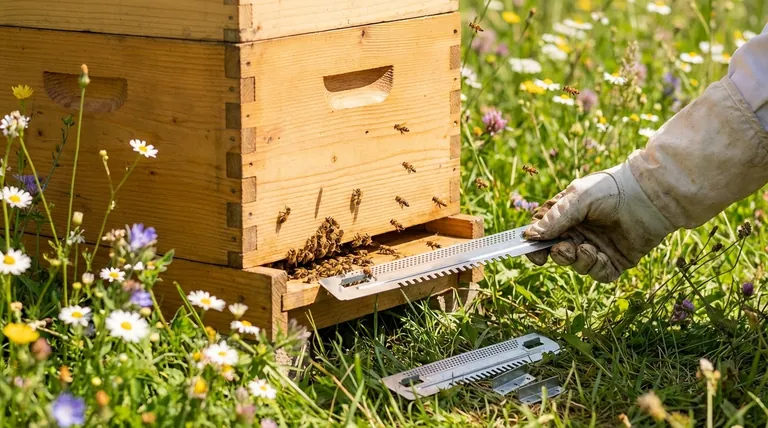In short, a beekeeper removes an entrance reducer during a strong summer nectar flow when the colony is large, healthy, and showing clear signs of traffic congestion at the hive entrance. Removing it allows the high volume of foraging bees to enter and exit more efficiently, maximizing their ability to gather resources.
The decision to remove an entrance reducer is a direct trade-off between hive defensibility and foraging efficiency. Your role is to assess whether your colony is strong enough to defend a larger entrance in exchange for faster access during peak season.

The Core Function of an Entrance Reducer
An entrance reducer is a simple but critical tool for managing a colony's strength and security. Its purpose is to shrink the hive entrance, providing specific advantages at different stages of the colony's life.
A Defensive Choke Point
The primary job of an entrance reducer is to make the hive easier to defend. A smaller entrance means fewer guard bees are needed to fend off robbers like wasps or bees from other colonies.
This protection is absolutely essential for new, small, or weak hives that don't yet have the population to defend a full-width opening.
Climate and Ventilation Control
A reduced entrance helps the colony manage its internal environment. It minimizes drafts in the winter, making it easier for the bees to maintain the cluster's temperature.
This regulation helps conserve the colony's energy and food stores during colder months.
Key Signals for Removing the Reducer
Your bees will show you when they are ready for more space. The decision should be based on observation, not a strict calendar date.
High Traffic and "Bearding"
The most obvious sign is a bottleneck. You will see foraging bees queuing up, struggling to get in and out of the restricted opening.
This congestion can sometimes lead to "bearding," where a large number of bees cluster on the outside of the hive due to high traffic and internal heat.
A Strong, Populous Colony
Only a large and thriving colony can afford a wide-open entrance. A strong hive has a robust population of guard bees ready to defend the larger territory against any potential threats.
If you see bees covering most of the frames during an inspection, it's a good indicator that they have the numbers to protect themselves.
Peak Nectar Flow
High traffic is typically driven by a major nectar flow. When local flowers are in full bloom, the bees work relentlessly.
Removing the reducer at this time directly supports their efforts, allowing for more foraging trips and, consequently, a larger honey harvest.
Understanding the Trade-offs
Like many beekeeping decisions, this one involves balancing risks and rewards. There is no single "correct" answer for every hive in every situation.
The Risk of Premature Removal
Removing the reducer too early is a common mistake that can have devastating consequences. It leaves a vulnerable colony exposed to being robbed of its resources.
A successful robbing attack can quickly destroy a weak colony. It is always better to be cautious and wait until you see clear signs of strength.
The Cost of Leaving It On Too Long
While less catastrophic, leaving a reducer on a strong colony during a nectar flow can hinder its productivity.
The traffic jam at the entrance directly limits the amount of nectar and pollen the bees can bring in, potentially reducing your final honey yield. It can also contribute to overheating within the hive.
The "Year-Round" Philosophy
Some beekeepers choose to leave reducers on all year, simply rotating to a larger opening during the summer.
This strategy prioritizes defense above all else. It is a valid approach, especially in areas with high robbing pressure or for beekeepers managing naturally weaker bee genetics.
Making the Right Decision for Your Hive
Ultimately, your choice depends on the specific state of your colony and your primary goal at that moment.
- If your colony is newly installed or appears weak: Keep the entrance reducer on its smallest setting to give the bees the best chance to defend their home.
- If your colony is strong and you see traffic jams during a nectar flow: Remove the reducer completely to maximize their foraging efficiency and honey production.
- If you are preparing for fall and winter: Re-install the reducer to help with temperature regulation and protect against late-season robbing as the population naturally declines.
Your best guide is always the behavior of the bees themselves; learn to read their signals, and you will know when to act.
Summary Table:
| Situation | Action | Reason |
|---|---|---|
| New, small, or weak colony | Keep reducer on | Essential for defense against robbers |
| Strong colony, high traffic during nectar flow | Remove reducer | Maximizes foraging efficiency & honey yield |
| Fall/Winter preparation | Re-install reducer | Aids in temperature regulation & defense |
Is your apiary ready for peak season? Ensure your colonies are equipped for maximum efficiency. HONESTBEE supplies commercial apiaries and beekeeping equipment distributors with the durable, high-quality supplies needed to manage strong, productive hives. Let us help you optimize your operation—contact our wholesale experts today to discuss your needs.
Visual Guide

Related Products
- Beehive Entrance Reducer Guardian Metal Hive Entrance for Bees
- Multi-Functional Sliding Hive Entrance for Beekeeping
- Multi-Functional Rotary Hive Entrance Disc for Beekeeping
- Professional Reversible Beehive Hive Entrance
- Professional Galvanized Hive Strap with Secure Locking Buckle for Beekeeping
People Also Ask
- What are the different entrance sizes for an 8 or 10-frame Langstroth hive? A Guide to Seasonal Management
- What size is the entrance hole in a native bee hive? The 13mm Standard for a Thriving Colony
- What happens if you seal an entrance to a bee hive? Avoid a Costly Structural Disaster
- What are the two functions of the Entrance Reducer? Master Hive Defense and Safe Transport
- How big should a beehive entrance be? Optimize for Colony Health & Honey Production



















